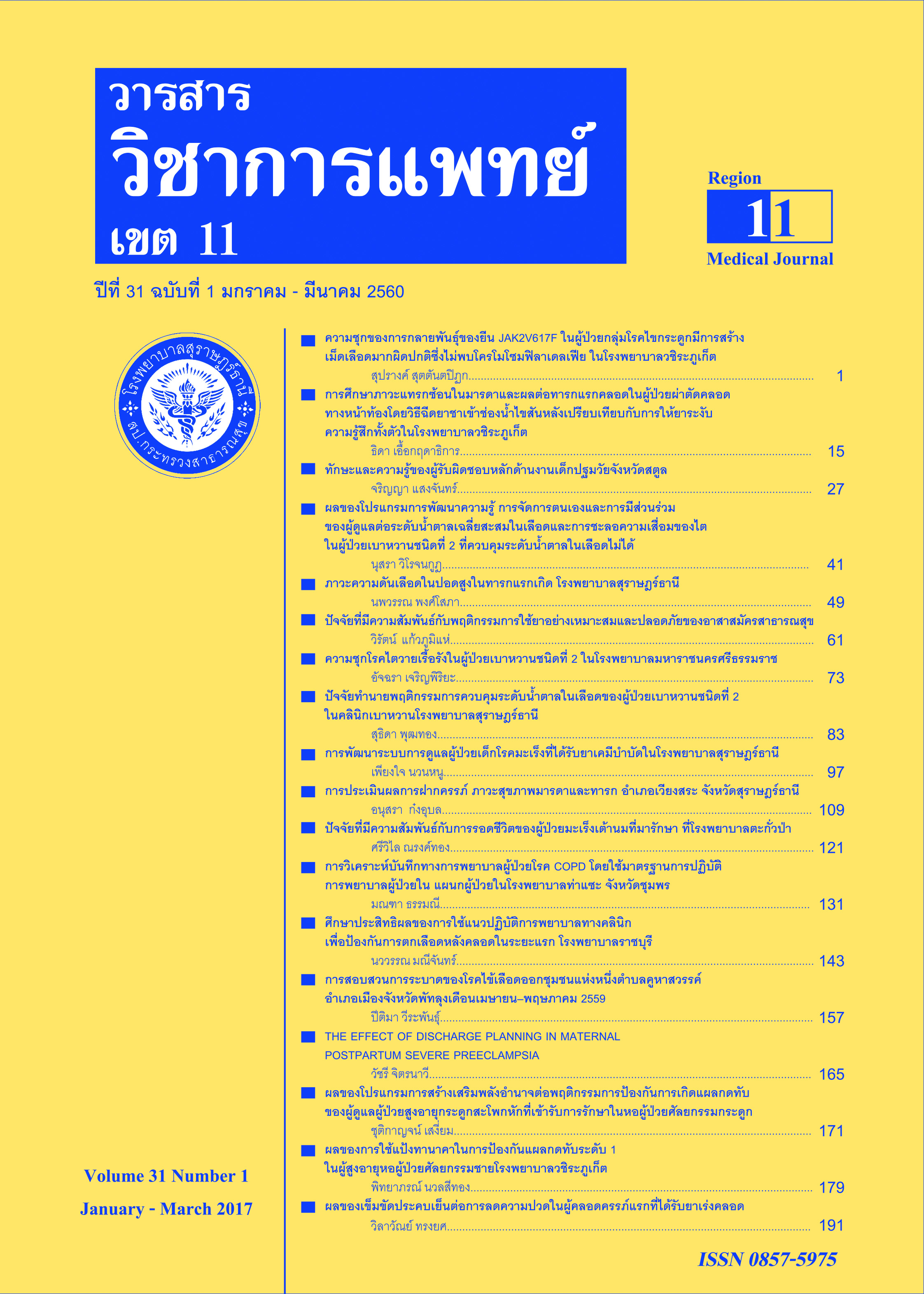ทักษะและความรู้ของผู้รับผิดชอบหลักด้านงานเด็กปฐมวัยจังหวัดสตูล
คำสำคัญ:
เด็กปฐมวัย, ผู้รับผิดชอบงาน, ทักษะ, ความรู้บทคัดย่อ
Background : An early childhood is the most importance age of development to be effectiveness adults. Implementation of growth evaluation, screening and developmental surveillance are needed and must be screened and evaluated by public health professional who have well experiences and skills.
Objective : To assess skills and knowledge for evaluation and advice about growth and development in early childhood of personnel primarily responsible for early childhood and factors associated with result of evaluation.
Method : This study was cross sectional analytic study. The subjects were 63 personnels primarily responsible for early childhood. The evaluation of skills and knowledge to assess and provide advice about growth and development in early childhood at age of 9 months, 18 months, 30 months and 42 months by Developmental Surveillance and Promotion Manual (DSPM) was done after personnel had trained the Developmental Surveillance and Promotion Manual (DSPM) for 13 months and after a campaign screening child development at age of 42 months for 10 months. Regarding the result of evaluation skills and knowledge was passed by having scores greater than 80%. Data was analyzed by using descriptive statistics, Chi-Square and Fisher’s extract test.
Results : A total of 63 personnels primarily responsible for early childhood enrolled to be assessed. Pass the assessment of knowledge and skills of 13
(20.6 %). From the result of evaluation showed that the knowledge to advise on development was mostly passed (77.9%), followed by advice on growth (73.0%) and the minimum was development assessment by DSPM (25.4 %). The study found that the age of developmental assessment. Ages could
be evaluated properly, the highest was aged 9 months (86.0 %) and lowest was aged 42 months (26.3%). For evaluation skills developmental assessment to determine the most accurate was the assessment of gross motor (63.5%) and the lowest was the expressive language (42.9%). The accurate of child preparation was 27.0% and equipment preparation was 36.5%. The most correct equipment was 9 months. (47.6 %). The minimum was 18 months (17.5%). Factors associated with result of evaluation included attitude to the job (p = 0.01), self study (p = 0.00) and use the DSPM to work (p = 0.04).
Conclusion : Personnel primarily responsible for early childhood. Satun, most still lack the skills to assess the growth and development of children. Those who pass the assessment, a group that has a good attitude to the job responsibility. Study more knowledge on their own and based on real operating manual
guidelines strict. To develop the knowledge and skills of the personnel. Training should have both the knowledge and skills about the growth and development of children. As well as monitoring and evaluation, as well as qualified personnel, thus allowing it to act under the control and supervision of quality standards by those who experienced it. To encourage early childhood health care quality further.
เอกสารอ้างอิง
นิตยา คชภักดี. การประชุมเชิงปฏิบัติการเรื่องการใช้เครื่องมือเฝ้าระวังและส่งเสริมพัฒนาการเด็กปฐมวัย (DSPM) [ออนไลน์].เข้าถึงได้จาก:http://thaichilddevelopment.
com/new/2-3-58/นิตยา%20%20หน้าต่างแห่งโอกาสปฐมวัย.pdf ; 2558 [สืบค้นเมื่อ 2 มีนาคม 2559].
นิตยา คชภักดี. แนวทางการปฏิบัติการคัดกรองพัฒนาการเพื่อส่งเสริมพัฒนาการเด็กในศูนย์เด็กเล็ก :โครงการส่งเสริมพัฒนาการเด็กปฐมวัยเฉลิมพระเกียรติสมเด็จพระเทพรัตนราชสุดาฯ สยามบรมราชกุมารี การประชุมเตรียมการรณรงค์คัดกรองพัฒนาการเด็กปฐมวัย ปี 2558 [ออนไลน์]. เข้าถึงได้จาก: http://www.hpc.go.th/director/data/dspm/childDev_nitaya.pdf
; 2558. [สืบค้นเมื่อ 25 พฤษภาคม 2559].
Joseph F. Hagan Jr, Paul M. Duncan. Maximizing children’s health screening, anticipatory guidance, and counseling. In: Kliegman RM, Jonson HB, Behrman RE, Stanton BF, editors. Nelson textbook of pediatrics. 18 th ed. Philadelphia: Saunders Elsevier; 2007. p. 27-31.
จันท์ฑิตา พฤกษานานนท์. การประเมินการเจริญเติบโต.ใน: นิชชา เรืองดารกานนท์, ชาคริยา ธีรเนตร, รวิวรรณ รุ่งไพรวัลย์, ทิพวรรณ หรรษคุณาชัย, นิตยา คชภักดี, บรรณาธิการ. ตำราพัฒนาการและพฤติกรรมเด็ก. กรุงเทพฯ. โฮลิสติก พับลิชชิ่ง; 2551. หน้า 436-48.
กรมอนามัย. สำนักโภชนาการ. คู่มือแนวทางการดำเนินงานส่งเสริมสุขภาวะด้านโภชนาการ ในคลินิกสุขภาพเด็กดี. กรุงเทพฯ: โรงพิมพ์สำนักงานพุทธศาสนาแห่งชาติ; 2558.
นิชชา เรืองดารกานนท์. การติดตามเฝ้าระวังพัฒนาการ.ใน: นิชชา เรืองดารกานนท์, ชาคริยา ธีรเนตร, รวิวรรณ รุ่งไพรวัลย์, ทิพวรรณ หรรษคุณาชัย, นิตยา คชภักดี, บรรณาธิการ. ตำราพัฒนาการและพฤติกรรมเด็ก. กรุงเทพฯ: โฮลิสติก พับลิชชิ่ง; 2551. หน้า 415-34.
กระทรวงสาธารณสุข. สำนักตรวจและประเมินผล.โครงการส่งเสริมพัฒนาการเด็กปฐมวัยเฉลิมพระเกียรติสมเด็จพระเทพรัตนราชสุดาฯ สยามบรมราชกุมารี เนื่องในโอกาสฉลองพระชนมายุ
5 รอบ 2 เมษายน 2558 ปี 2559. นนทบุรี: กระทรวง; 2559.
กรมอนามัย. สำนักส่งเสริมสุขภาพ. กลุ่มงานอนามัยแม่และเด็ก. คู่มือปฏิบัติการคลินิกสุขภาพเด็กดีแนวทางการดำเนินส่งเสริมสุขภาวะด้านโภชนาการ ในคลินิกสุขภาพเด็กดี. พิมพ์ครั้งที่ 2. นนทบุรี: กรม; 2557.
กรมอนามัย. สำนักส่งเสริมสุขภาพ. กลุ่มงานอนามัยแม่และเด็ก. คู่มือมาตรฐานงานอนามัยแม่และเด็ก [ออนไลน์]. เข้าถึงได้จาก: http://cpho.moph.go.th/system_ssj_ebook/pdf/2016 - 03/cph-book_2_32741.pdf; [สืบค้นเมื่อ 25 พฤษภาคม 2559].
แนวคิด Child Development Series [ออนไลน์]. เข้าถึงได้จาก: http://hpc5.anamai.moph.go.th/director/dspm/index_child.php; [สืบค้นเมื่อ 17 มีนาคม 2560].
อนามัย 49 (พัฒนาการเด็กปฐมวัย). [ออนไลน์]. เข้าถึงได้จาก: http://nitade.pkn2.go.th/pattanakan.pdf; [สืบค้นเมื่อ 2 กุมภาพันธ์ 2560].
กรมอนามัย. สำนักส่งเสริมสุขภาพ. กลุ่มงานอนามัยแม่และเด็ก. แบบคัดกรองและส่งเสริมพัฒนาการเด็ก (อนามัย 55). นนทบุรี: กรม; 2556.
สำนักงานกองทุนสนับสนุนการสร้างเสริมสุขภาพ. คู่มือเฝ้าระวังและส่งเสริมพัฒนาการเด็กปฐมวัย Development surveillance and promotion manual (DSPM). พิมพ์ครั้งที่ 3. นนทบุรี: ทีเอสอินเตอร์พริ้น; 2558.
สำนักงานกองทุนสนับสนุนการสร้างเสริมสุขภาพ. คู่มือประเมินและส่งเสริมพัฒนาการเด็กกลุ่มเสี่ยง Developmental Assessment for Prevention Manual (DAIM). พิมพ์ครั้งที่ 3. นนทบุรี: ทีเอสอินเตอร์พริ้น; 2558.
แพทย์หญิงศิริพร กัญชนะ. หลักการคัดกรองและส่งเสริมพัฒนาการเด็กแรกเกิด – 5 ปี ด้วย DSPM และ DAIM [ออนไลน์]. เข้าถึงได้จาก: http://thaichilddevelopment.com/new/23-3-58/หลักการคัดกรองและส่งเสริมพัฒนาการเด็กแรกเกิด-5ปี%20อ.ศิริพร-2.pdf; 2558 [สืบค้นเมื่อ 2 มีนาคม 2558].
จินตนา พัฒนพงศ์ธร, อาริสรา ทองเหม. การคัดกรองพัฒนาการตามวัยเด็กปฐมวัย. ใน: กรมอนามัย. คู่มือนักส่งเสริมพัฒนาการเด็กปฐมวัย หลักสูตรเร่งรัดประจำโรงพยาบาล. นนทบุรี: กรม; 2500. หน้า 31-44.






